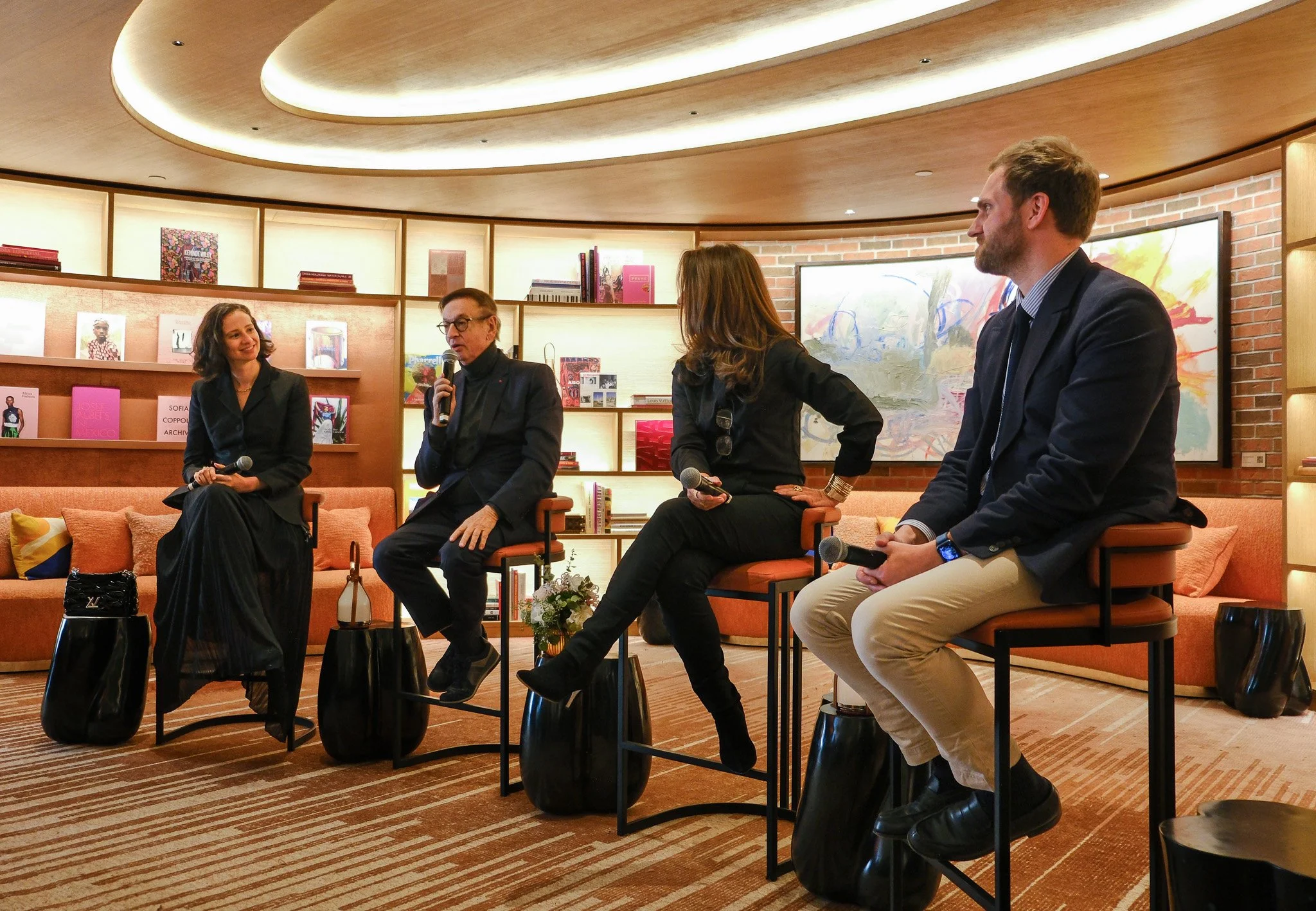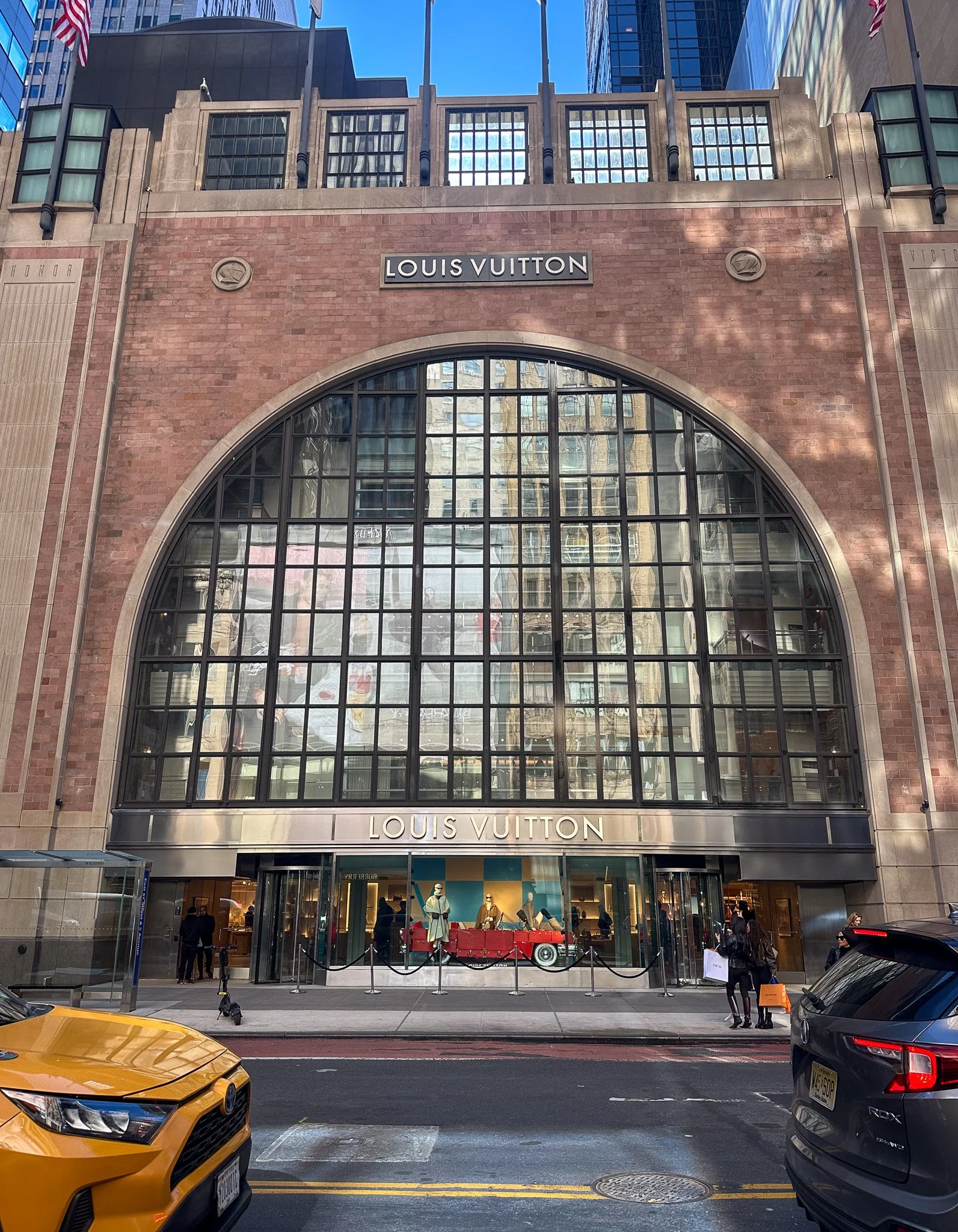Espace Louis Vuitton New York Pop-Up: Impressionist Painter and Patron Gustave Caillebotte
A conversation among, left to right, the moderator; Jean-Paul Claverie of the Fondation Louis Vuitton; Katherine Elizabeth Fleming of the J. Paul Getty Trust and Paul Perrin of the Musée d'Orsay. Photo by Jamie Lubetkin
Louis Vuitton unveiled its first New York art exhibition Monday with the kind of flex only a global fashion empire could muster—two Gustave Caillebotte masterpieces installed on the fifth floor of its temporary 57th Street store, above an atrium with luxury trunks stacked like architectural columns. One floor below, amid swirling champagne and steaming espresso, an art conversation explored the patrician artist’s historical significance. And on the floors below, shoppers examined luxury handbags and pricey ready-to-wear, oblivious to the 19th-century Impressionist masterworks above them.
The exhibition was billed as being held at Espace Louis Vuitton New York, but that doesn’t mean the luxury retail giant is adding a full-time gallery (“espace”) to its flagship Manhattan store just yet. Currently, there are full-time galleries at LV locations in Venice, Munich, Tokyo, Beijing, Seoul and Osaka. This one is more of a pop-up, though additional shows seem likely.
"Yes, it's the first time in New York, but it's not the first step for Louis Vuitton because, as you know, we have many, many locations around the world where we present art," Jean-Paul Claverie, advisor to the chairman of Fondation Louis Vuitton, told attendees during the conversation portion of yesterday’s opening. "In New York, it's the first time and maybe it is not the last."
Jean-Paul Claverie, Administrator, Advisor to the Chairman, Fondation Louis Vuitton, Paris, speaking at the opening. Photo by Jamie Lubetkin
The Caillebotte exhibition runs through November 16 with Young Man at His Window (1876) on loan from the J. Paul Getty Museum in Los Angeles and Boating Party (1877-1878) from the Musée d'Orsay in Paris. It's a focused, surgical presentation: two paintings, both from the late 1870s when Caillebotte established himself as a worthy Impressionist practitioner as well as a friend and patron of the era’s greats.
Paul Perrin, chief curator at the Musée d'Orsay, positioned Caillebotte as an artist experiencing a contemporary renaissance. "He's not one of the most famous artists, but he is becoming one of the great Impressionists now," Perrin said during Monday's conversation. He noted there hasn't been a Caillebotte exhibition in New York since the 1970s and suggested that the city has largely overlooked the painter who bankrolled Monet, Renoir, and Pissarro while creating his own quietly revolutionary body of work.
Caillebotte'sYoung Man at His Window. Photo by Jamie Lubetkin
Young Man at His Window shows Caillebotte's younger brother René silhouetted against a sun-drenched Haussmann boulevard, the figure dark and precise while the street below dissolves into Impressionist light. The painting debuted at the second Impressionist exhibition in 1876, the same year Caillebotte joined the group at age 28. It's a threshold work in every sense—the figure caught between interior darkness and exterior brightness, between old Paris and the modern city Haussmann had razed and rebuilt just years earlier.
Katherine Elizabeth Fleming, president and CEO of the J. Paul Getty Trust, described encountering the painting for the first time after joining the Getty three years ago. "You're immediately drawn into it, you're almost the man at the window, you're almost like hurdled through the dark room and out into the bright street that he's looking out over," Fleming said. "And you have to remember that what he's looking at is a very modern, for him, city of Paris."
Perrin read the painting biographically. "Someone who is on the inside, but projecting himself to outside in the city and the movement of the city, but still, he is in between two spheres," he explained. "I think this painting really embodies the state of mind of a young, rich Parisian, who doesn't have to work, doesn't have to do almost anything with his life, because he doesn't need to. But he wants to do something great with his life." That biographical detail hits harder when you know Caillebotte painted "Young Man at His Window" the same year René died of tuberculosis.
At 28, Caillebotte wrote his will, leaving his Impressionist collection to the French state—a collection he'd only just begun assembling. Caillebotte recognized at the time that impressionism was a new and radical movement. Caillebotte “says in his will, 'I know that it will take some time for people to understand these paintings,' but he's really convinced that this is the art of the future," Perrin said.
Caillebotte's Boating Pary. Photo by Jamie Lubetkin
Boating Party represents Caillebotte two years deeper into the movement, fully integrated with the Impressionists and painting their signature leisure subjects—but with his characteristic photographic precision. A bourgeois rower in a formal vest and top hat navigates a quiet river, striped shirt visible beneath his jacket, oar blades cutting geometric angles through green water. The composition is radically cropped, the figure monumentalized and thrust forward like a film close-up.
"When he exhibits this painting in 1879, he's really considered one of the greatest and among the more radical painters of his time," Perrin noted.
Perrin emphasized the rower's deliberate elegance—the top hat worn during athletic activity and the striped shirt that signaled dandy status in the 1870s. "It's really about the man from the city who is really looking at his appearance, who is very handsome, who is stylish, and goes to the suburbs to make some sport," Perrin said.
The conversation emphasized Caillebotte's absorption of photographic vision—his use of radical cropping, flattened perspective, and viewer immersion. "Caillebotte introduces the spectator into his picture…. And that's really modern," Claverie said.
Louis Vuitton's temporary 57th Street store. Photo by Jamie Lubetkin
The Espace Louis Vuitton New York represents the luxury house formalizing what it's done informally for years—integrating art into its retail spaces. For a brand built on luxury luggage and high-tone style, showing two paintings about modern urban life and leisure signals that haute couture and high art occupy the same stratosphere.
The artist would recognize the transaction: he spent his career funding other people's visions while creating his own, never painting to sell, never chasing the market. Caillebotte painted what mattered to him, and a century later, the art world may be catching up.





